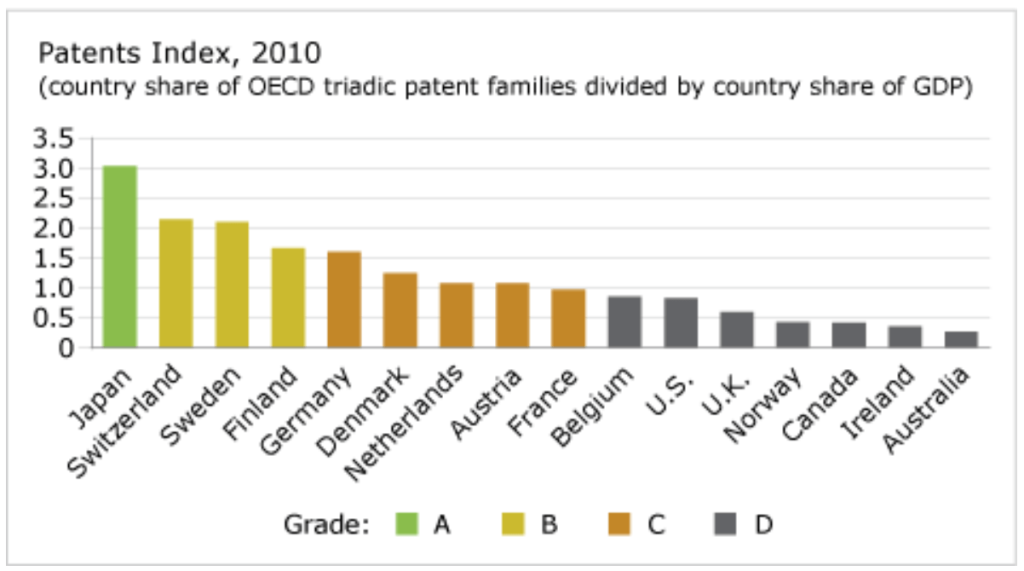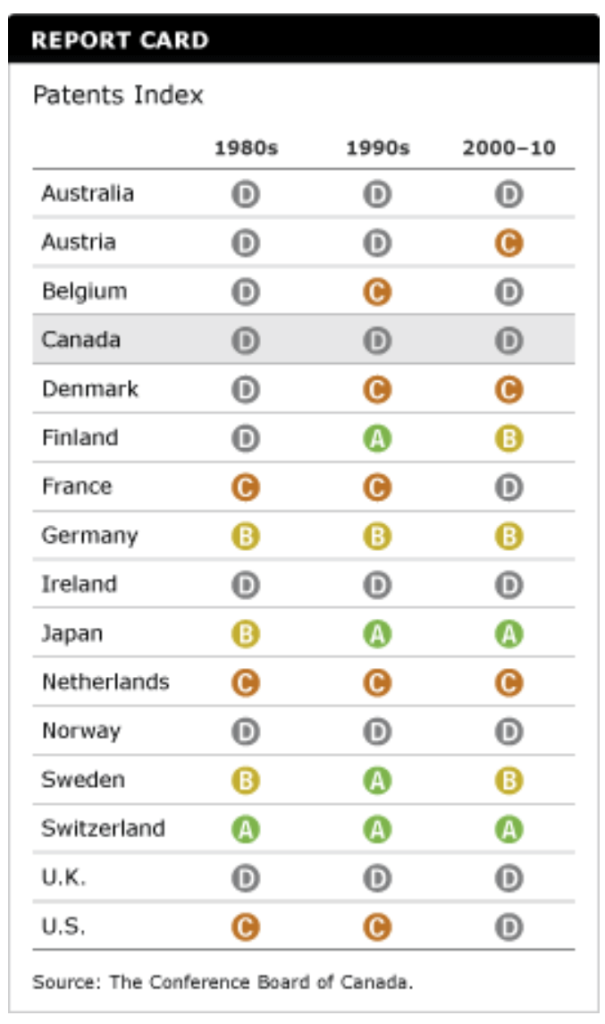Patents Index
Key Messages
- Canada gets a “D” and ranks 14th among the 16 peer countries.
- Canada is “punching below its weight” when it comes to patenting.
- The good news, however, is that Canada’s patents index score has been increasing.

What is a patent?
A patent is a government-granted right that gives inventors a monopoly to make, sell, and use their inventions for a certain period of time. In exchange, the inventor must disclose the details of the invention so others can make use of them when the patent expires.
Counting patents helps gauge how well countries transform knowledge into usable inventions. Countries with more patents are in a better position to pioneer new-to-world technologies and therefore derive above-average economic gains from intellectual property. The Canadian Intellectual Property Office describes the link between patents and the nation’s welfare:
By giving inventors monopolies on their creations for a specific time period, patents protect investments and allow inventors to profit financially from their creativity. This in turn provides an attractive incentive for research and development, ultimately benefiting all Canadians. Without the possibility of patent protection, many people might not take the risk of investing the time or money necessary to create or perfect new products, without which our economy would suffer.
Patents do more than make money and encourage creativity, however. They are also a means of sharing cutting-edge information. Because each patent document describes a new aspect of a technology in clear and specific terms and is available for anyone to read, they are vital resources for businesses, researchers, academics, and others who need to keep up with developments in their field.1
Of course, not all patents are equally valuable. Counting triadic patents—that is, those submitted for the same invention to patent offices in the U.S., EU, and Japan—reduces some sources of sample bias and ensures that the patents counted are worth counting.
How is the patents index calculated?
The patents index ranks countries by their patents output relative to their economic size. It is the ratio of a country’s share in the total number of OECD triadic patent families to its share in total OECD GDP. If a country’s share in OECD triadic patent families matches its relative share in OECD GDP, the country’s patents index is one. In other words, a patents index value of one means that the country’s importance in overall OECD patenting matches its economic importance within the OECD.
A score greater than one indicates a larger share of patents relative to GDP, meaning that the country is more successful in patenting than the size of its economy would warrant. A score less than one indicates a smaller share of patents relative to GDP, meaning that the country is less successful in patenting than the size of its economy would warrant.
Why is the patents index important to innovation?
Patents protect inventions in return for divulging their secrets. They thus encourage invention on the one hand and the spread of new technical knowledge on the other. Patents are a convenient way of estimating the relative amount of invention among countries. Taken together with other indicators, patents provide a rough-and-ready indication of relative innovation capacity and performance.
What are the shortcomings of using patents to measure innovation?
Patents measure invention. But invention is not innovation: innovation occurs when inventions become commercialized into world-changing products or services.
Patents also have some generally recognized shortcomings as indicators of innovation:
- Innovative companies may not patent an invention because the procedure is deemed too costly.
- A company may choose other methods—such as trade secret protection—to secure an invention from theft.
- In networked industries as varied as railroads and video games, companies find that sharing invention globally to improve performance of the network as a whole is a better strategy than patenting.
Nevertheless, comparing patents—especially patents around the same invention (patent families)—in the three main patent areas (North America, Europe, and Japan) does help indicate relative national innovative abilities and capacities.
How does Canada’s performance on the patents index compare to its peers?
Canada ranks 14th out of 16 peer countries on this report card, with a corresponding grade of “D.” Canada’s patenting index is 0.42, suggesting that its importance in patenting within the OECD is less than it should be given the relative size of its economy. In 2010, Canada accounted for over 3 per cent of total OECD GDP, yet accounted for only 1.3 per cent of total OECD triadic patents. In other words, Canada is “punching below its weight” when it comes to patenting.
Who are the leaders on this report card?
The only country with an “A” is Japan. Japan accounts for 10 per cent of total GDP in the OECD, yet is responsible for 30 per cent of OECD triadic patents. This gives Japan a patents index score of 3.
Switzerland, Sweden, and Finland are all “B” performers, with much greater patenting activity than the size of their economies would warrant.
Why is the U.S. a “D” performer?
The U.S. accounts for 29 per cent of all OECD triadic patents, the second highest (after Japan) among OECD countries. But the U.S. accounts for 35 per cent of the total GDP of OECD countries, resulting in a patents index that is less than one. This suggests that the U.S. is not patenting as much as the relative size of its economy would suggest it should be.
Has Canada grade improved on this report card?

No. Canada has been a “D” performer since the mid-1980s, as have Australia, Austria, Ireland, Norway, and the United Kingdom. The good news, however, is that Canada’s patents index score has been increasing—from 0.28 in 1985 to 0.42 in 2010.
The only “A” performer in all three decades has been Switzerland, although its share of total OECD triadic patents has been falling. Switzerland slipped from an “A” in every year from 2000 to 2009 to a “B” in 2010.
What can Canada do to improve its grade?
By making patenting of intellectual property a business objective and by patenting strategically around inventions, Canada can pull up its grade in this report card, which has languished in the “D”s for the past few decades. Patenting gives a country “skin in the game,” something that can be traded with other firms when there is a need to combine inventions to create a new product.
What’s more, Canadian companies don’t have to patent Canadian inventions to introduce new-to-world innovations—they could also be taking more initiative to patent high-value products and services that originate elsewhere in the world. Products that result from international collaborative research are integral to today’s global supply chains, and these products are available to the businesses and the countries that make patenting a key part of their strategic business plans.
Footnotes
1 Canadian Intellectual Property Office, A Guide to Patents: Part I.

